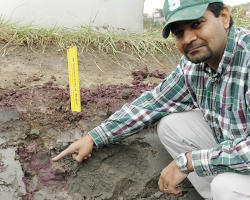Transforming Landfills into Landscapes
- Milind V. Khire, Ph.D.
- Associate Professor
- Department of Civil and Environmental Engineering
- College of Engineering
There's no question that landfill issues are important. For many, the thought of a landfill may conjure up a "can't live with it, can't live without it" attitude. But what if a completed landfill could be turned into a productive, sustainable thing of beauty? This may seem like a contradiction, but for Milind Khire, associate professor in MSU's Department of Civil and Environmental Engineering, turning this "contradiction" into a reality is a goal he's been achieving since 1991.

Khire first became interested in soil-related problems at the University of Miami in the early 1990s. He says, "In the 1970s and 80s we saw so many problems because of our mistakes in the 50s and 60s…We had a poor understanding of hydrology and ground water." Khire's desire to work on these problems evolved into an interest in researching landfill management. Over the years, his expertise has been applied to many sites nationally and internationally, including New Zealand, where he was involved in the design of virtually all of their major landfills, and the state of Washington, where he developed methods that are now routinely applied to design landfill covers in states west of the Mississippi River.
A key issue in landfill management is managing leachate, the fluid that accompanies waste in a landfill. While involved in landfill consulting projects prior to joining MSU, Khire discovered that the uneven distribution of leachate was causing the landfills to operate inefficiently, and that managing leachate within the landfill footprint is better for groundwater safety. So in 2002, soon after joining MSU, the first grant he obtained as the lead investigator was to test the concept he refers to as a permeable "blanket."
The blanket consists of a permeable layer, made from inexpensive recycled materials such as tires or crushed glass, which allows leachate to be injected and evenly circulated in the landfill. He field tested and proved the concept at a landfill in Jackson. According to Khire, this allows for much faster decomposition and an immediate gain in air space. It also produces cleaner leachate, reduces leachate treatment costs, and makes it easier to collect gases that can be turned into energy. This "blanket" system is now being used in many landfills.
A Challenging Future for Landfill Companies and a Long-term Vision
Over the past several years Khire has established partnerships with landfill companies in Minnesota and Michigan, and is currently working on the Woodland Meadows RDFExternal link - opens in new window near Detroit. The project, funded by Waste Management, Inc.External link - opens in new window and the Environmental Research and Education FoundationExternal link - opens in new window, addresses the issue of capping the landfill once it is full. Current Environmental Protection Agency (EPA) standards require a plastic component in the cap to be placed over the site, but this has some challenges. According to Khire, the plastic is expensive and there's no way to know what happens to the plastic over time. Since nothing can be grown on top of plastic, soil erosion is a big problem, creating dangerous and unsightly conditions. And because the owners are only liable for a site for about 30 years, if erosion occurs after that, dangerous substances can make the soil and groundwater unsafe.
Khire and his partners at Woodland Meadows are addressing these challenges by implementing what Khire calls an evapotranspirative cap. These earthen caps are composed of several feet of glacial clay or native soil(s) applied over the completed landfill. The clay, taken directly from the landfill site, allows for grasses and trees to be planted over the fill, preventing erosion and creating a more beautiful space. Khire says, "It's also much less expensive, saving up to a few million dollars, allowing some funding for other business opportunities."
Khire's partners at the Woodland facility appreciate the expertise he brings to the project. Eric Wallis, Director of the Waste Management Groundwater Protection Programs, says, "He understands the issues we're dealing with, and brings his expertise to help us deal with them." What is it that excites Khire about his work with landfills? "We are developing a sustainable safeguard for our environment by having a long-term vision," he says, "and the fact that tools, such as the 'blanket' are elements that can be used right away, gives me the most satisfaction."
Theoretical and Technical Skill - Plus Energy and Enthusiasm
Khire also gets satisfaction from including his graduate students in these projects. He says, "This gives them the opportunity to gain experiences that they could never get in a lab." One of his students, Ramil Mijares, is working closely with Khire at the Detroit site. Mijares appreciates the valuable experience he's gained from the project, and says, "Dr. Khire is a hands-on advisor; he really spends time with me teaching everything I need to know about all aspects of the project so that I can eventually manage a project on my own."
That Khire clearly loves the work he's doing is evident to his partners. Wallis says about Khire, "He's a get-out, get-dirty kind of person, not just theoretical —though he does that, too. But he brings it to the field with him. He has energy and enthusiasm for the type of analysis we're looking for, and his technical competence is without question."
For more information about the work Khire is doing at the Woodland Meadows facility, visit the project Web site.External link - opens in new window
- Written by Amy Byle, University Outreach and Engagement
- Photographs courtesy of Milind V. Khire